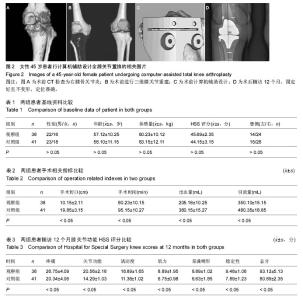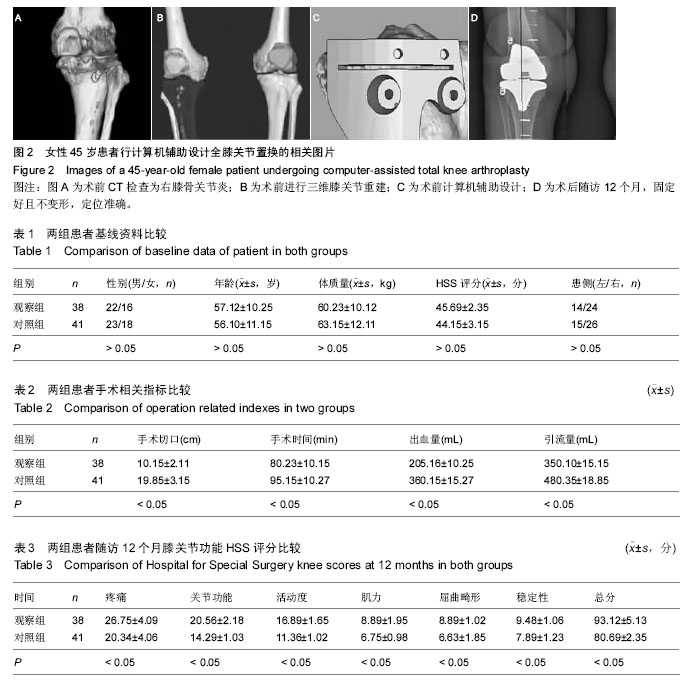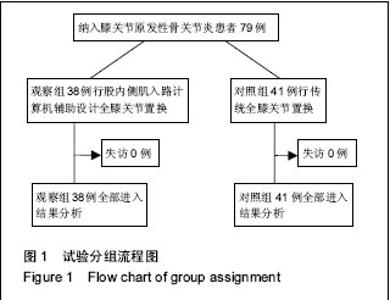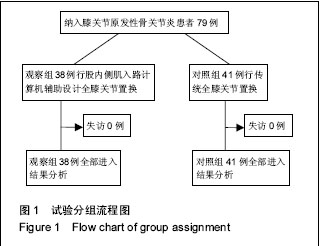Chinese Journal of Tissue Engineering Research
Previous Articles Next Articles
A comparison of computer-assisted total knee arthroplasty through vastus medialis approach and conventional arthroplasty
Liu Peng1, Liu Ping-ping2
- 1First Department of Orthopedics, Hengshui Halison International Peace Hospital (Hengshui People’s Hospital), Hengshui 053000, Hebei Province, China; 2Department of Orthopedics, Second Affiliated Hospital of Hebei Medical University, Shijiazhuang 050000, Hebei Province, China
-
Revised:2016-04-09Online:2016-05-27Published:2016-05-27 -
Contact:Liu Peng, Physician, First Department of Orthopedics, Hengshui Halison International Peace Hospital (Hengshui People’s Hospital), Hengshui 053000, Hebei Province, China -
About author:Liu Peng, Physician, First Department of Orthopedics, Hengshui Halison International Peace Hospital (Hengshui People’s Hospital), Hengshui 053000, Hebei Province, China -
Supported by:the Scientific Research Foundation of Hebei Medical University, No. 20123011
CLC Number:
Cite this article
Liu Peng, Liu Ping-ping. A comparison of computer-assisted total knee arthroplasty through vastus medialis approach and conventional arthroplasty[J]. Chinese Journal of Tissue Engineering Research, doi: 10.3969/j.issn.2095-4344.2016.22.002.
share this article

2.2 基线资料比较 对2组患者的基线资料进行统计学比较,差异均无显著性意义(P均> 0.05),具有可比性,具体结果见表1。 2.3 两组患者手术相关指标比较 观察组的手术切口显著小于对照组,手术时间显著短于对照组,总出血量和引流量均显著少于对照组(P均< 0.05),具体结果见表2。 2.4 两组患者末次随访膝关节功能评分比较 2组患者均接受12个月的随访,经末次随访,分别对入组患者进行膝关节功能HSS评分评定,可得经人工全膝关节置换之后,至末次随访观察组患者的膝关节功能各项指标得分以及总分均显著高于对照组,经比较差异均有显著性意义(P均< 0.05),具体结果如表3所示。 2.5 两种患者置换后并发症发生情况比较 经随访,观察组患者均未出现置换后感染和人工假体松动以及骨折等不良事件。对照组有4例出现假体松动,1例出现切口感染,均经积极处理后明显好转,未出现严重并发症。观察组的并发症发生率显著低于对照组(P < 0.05)。 2.6 典型病例 女性患者,45岁,右膝反复肿痛、活动受限入院。临床查体右膝内翻畸形,诊断为右膝骨关节炎(图2A),属于人工全膝关节置换适应证。征得患者及其家属知情同意之后,实施计算机辅助设计人工全膝关节置换治疗。置换前进行三维膝关节重建(图2B),计算机辅助测量并进行设计(图2C),3D打印导板及患侧膝关节模型,术中进行准确的假体置入,分离软组织少(图2D)。置换后随访12个月,固定好且不变形,定位准确。膝关节功能显著改善,且未出现术后感染和人工假体松动以及骨折等不良事件。"

| [1] 张淼,白波,陈艺,等.全膝置换术经小切口股内侧肌入路与标准髌旁入路临床疗效比较的 META 分析[J].中华关节外科杂志(电子版),2014,8(3):358-366.
[2] 徐应龙,赵劲民,李书振,等.全膝关节置换术股内侧肌入路与内侧髌旁入路比较的系统评价[J].中国循证医学杂志, 2010,10(5):585-591.
[3] 徐应龙.全膝关节置换术经股内侧肌入路与内侧髌旁入路比较置入假体的系统评价[D].广西医科大学,2010.
[4] 付勇,吴子祥,韩一生,等.Laptop Stryker手术导航仪辅助下人工全膝关节置换术在市级医院的应用[J].泸州医学院学报,2013,36(4):384-386.
[5] 余正红,蔡胥,李鉴轶,等.膝关节血供三维可视化研究及其临床意义[J].中华关节外科杂志(电子版),2007,1(4): 227-231.
[6] Brinkman JM, Bubra PS, Walker P, et al. Midterm results using a medial pivot total knee replacement compared with the Australian National Joint Replacement Registry data. ANZ J Surg. 2014;84(3):172-176.
[7] Brandon SC, Miller RH, Thelen DG, et al. Selective lateral muscle activation in moderate medial knee osteoarthritis subjects does not unload medial knee condyle. J Biomech. 2014;47(6):1409-1415.
[8] Hussain SM, Wang Y, Muller DC, et al. Association between index-to-ring finger length ratio and risk of severe knee and hip osteoarthritis requiring total joint replacement. Rheumatology. 2014;53(7):1200-1207.
[9] Wang L, Vieira RL, Rybak LD, et al. Relationship between knee alignment and T1ρ values of articular cartilage and menisci in patients with knee osteoarthritis. Eur J Radiol. 2013;82(11):1946-1952.
[10] 张树栋,刘克贵,王诗军,等.计算机辅助技术和传统工具下全膝关节置换术后髌骨位置放射学比较[C].//第一届全国计算机辅助外科学术会议论文集,2008:30-31.
[11] Karachalios T,Giotikas D,Roidis N, et al.Total knee replacement performed with either a mini-midvastus or a standard approach: a prospective randomised clinical and radiological trial. J Bone Joint Surg. 2008; 90/A(5): 584-591.
[12] 高英健,王伟力.微创膝关节置换的临床应用现状[J].中国组织工程研究,2013,17(39):6985-6990.
[13] 赵喜滨,李斌,王浩,等.导航技术与传统方法膝关节置换后力线测量的Meta分析[J].实用骨科杂志,2010,16(12): 897-902.
[14] 杜辉,张纪,唐浩,等.计算机辅助导航人工膝关节置换手术的效果观察[J].山东医药,2014,54(36):74-76,77.
[15] Dempsey KE, Collins JE, Ghazinouri R, et al. Associations between preoperative functional status and functional outcomes of total joint replacement in the Dominican Republic.Rheumatology. 2013;52(10):1802-1808.
[16] Nutton RW,van der Linden ML,Rowe PJ, et al.A prospective randomised double-blind study of functional outcome and range of flexion following total knee replacement with the NexGen standard and high flexion components. J Bone Joint Surg. 2008;90/B(12):37-42.
[17] Nutton RW,van der Linden ML,Rowe PJ,et al.A prospective randomised double-blind study of functional outcome and range of flexion following total knee replacement with the NexGen standard and high flexion components. J Bone Joint Surg. 2008;90/A(1):37-42.
[18] 李斌,瓦热斯江-尼亚孜,赵喜滨,等.计算机导航治疗与传统方法进行膝关节置换手术效果比较的系统评价[J].中国循证医学杂志,2010,10(11):1259-1268.
[19] 许伟华,杨述华,陈东,等.计算机导航辅助下和传统人工膝关节置换术后下肢力线和假体位置的比较[C].//全国骨关节与风湿病暨第三届武汉国际骨科高峰论坛论文集,2012:54-56.
[20] 吴昊.计算机辅助人工膝关节置换手术系统简介[J].国外医学:骨科学分册,2005,26(3):137-140.
[21] Hamel MB, Toth M, Legedza A, et al.Joint replacement surgery in elderly patients with severe osteoarthritis of the hip or knee: decision making, postoperative recovery, and clinical outcomes. Arch Int Med. 2008;168(13): 1430-1440.
[22] Chang AH, Lee SJ, Zhao H, et al. Impaired varus-valgus proprioception and neuromuscular stabilization in medial knee osteoarthritis. J Biomech. 2014;47(2):360-366.
[23] Loughnan TE, Taverner MG, Webb A, et al. Randomized, Double Blinded Comparative Trial ofIntradermal Injections of Lignocaine Versus N-SalineAround the Knee to Relieve Pain in Patients AwaitingTotal Knee Replacement. Clin J Pain. 2009;25(4):269-272.
[24] Gillam MH, Lie SA, Salter A, et al. The progression of end-stage osteoarthritis: Analysis of data from the Australian and Norwegian joint replacement registries using a multi-state model. Osteoarthritis Cartilage. 2013;21(3):405-412.
[25] 许伟华,杨述华,陈东,等.计算机导航辅助下和传统人工膝关节置换术后下肢力线和假体位置的比较[C].//第21届中国康协肢残康复学术年会暨第二届“泰山杯”全国骨科青年科技创新论坛论文集,2012:174.
[26] 吴昊,Van Driessche St(e)phane, Daniel Goutallier,等.三维骨建模系统在人工全膝关置换中的优化用用:导肮与规手术早期疗效比较[J].中国组织工程研究与临床康复, 2008,12(13):2564-2568.
[27] 李斌,瓦力斯,王浩,等.计算机导航技术比较传统方法进行膝关节置换术后力线测量的系统评价[C].//第七届西部骨科论坛暨青海省骨科年会论文集,2011:78-78.
[28] Singh JA, Lewallen DG. Cerebrovascular disease is associated with outcomes after total knee arthroplasty: A us total joint registry study. J Arthroplasty. 2014;29(1): 40-43.
[29] Wallis JA, Taylor NF. Pre-operative interventions (non-surgical and non-pharmacological) for patients with hip or knee osteoarthritis awaiting joint replacement surgery-a systematic review and meta-analysis. Osteoarthritis Cartilage. 2011;19(12):1381-1395.
[30] Lundberg HJ, Foucher KC, Andriacchi TP, et al. Direct comparison of measured and calculated total knee replacement force envelopes during walking in the presence of normal and abnormal gait patterns. J Biomech. 2012;45(6):990-996.
[31] 李桓毅,刘方刚,陈建明,等.计算机导航下全膝关节置换截骨的精确度比较[C].//第十一届全军骨科学术大会论文集, 2010:430-431.
[32] 吴昊,Van Driessche Stéphane, Goutallier Daniel, 等.三维骨建模系统在人工全膝关节置换旋转对位中的作[J].中国组织工程研究与临床康复,2009,13(35):6987-6990.
[33] Matsumoto T,Kuroda R,Kubo S,et al.The intra-operative joint gap in cruciate-retaining compared with posterior-stabilised total knee replacement. J Bone Joint Surg. 2009;91/B(4):475-480.
[34] Gooch K, Marshall DA, Faris PD, et al. Comparative effectiveness of alternative clinical pathways for primary hip and knee joint replacement patients: A pragmatic randomized, controlled trial.Osteoarthritis Cartilage. 2012;20(10):1086-1094.
[35] 裴福兴,李程,杨静,等.计算机导航全膝关节置换系统的初步临床应用[C].//第2届中国重庆关节外科国际学术研讨会暨第二届全军关节镜学术研讨会论文集, 2005: 163-166.
[36] Liu YH,Wang TM, Wei IP, et al.Effects of bilateral medial knee osteoarthritis on intra- and inter-limb contributions to body support during gait. J Biomech. 2014;47(2): 445-450.
[37] Alghadir A, Omar MT, Al-Askar AB, et al.Effect of low-level laser therapy in patients with chronic knee osteoarthritis: A single-blinded randomized clinical study.Lasers Med Sci. 2014;29(2):749-755.
[38] 《中国组织工程研究与临床康复》杂志社学术部.人工膝关节临床应用中的假体设计、生物力学性能、计算机辅助技术及其相关争议[J].中国组织工程研究与临床康复, 2010,14(9):1658-1660.
[39] 严志强,张乐,王新亮,等.计算机辅助设计兔解剖型人工膝关节假体[J].广东医学,2014,35(13):1997-2001.
[40] 石更强.基于逆向工程个性化三维仿生膝关节股骨和胫骨部分的精确建模[J].中国组织工程研究与临床康复, 2008,12(35):6831-6834. |
| [1] | Liang Xin, Wang Heng, Li Xian-rong. Preoperative application of alprazolam for patients with anxiety and depression and pain after total knee arthroplasty: its safety and effectiveness [J]. Chinese Journal of Tissue Engineering Research, 2017, 21(7): 985-992. |
| [2] | Shi Bin, An Jing, Chen Long-gang, Zhang Nan, Tian Ye . Influencing factors for pain after total knee arthroplasty [J]. Chinese Journal of Tissue Engineering Research, 2017, 21(7): 993-997. |
| [3] | Wang Xian-xun. Impact of local compression cryotherapy combined with continuous passive motion on the early functional recovery after total knee arthroplasty [J]. Chinese Journal of Tissue Engineering Research, 2017, 21(7): 998-1003. |
| [4] | Lu Yao-jia, Xiong Chuan-zhi, Li Xiao-lei, Hu Han-sheng, Chen Gang, Wang Qiang, Lu Zhi-hua. Comparison of two methods for reducing blood loss during total knee arthroplasty [J]. Chinese Journal of Tissue Engineering Research, 2017, 21(7): 1004-1008. |
| [5] | Yuan Wei, Zhao Hui, Ding Zhe-ru, Wu Yu-li, Wu Hai-shan, Qian Qi-rong. Association between psychological resilience and acute mental disorders after total knee arthroplasty [J]. Chinese Journal of Tissue Engineering Research, 2017, 21(7): 1015-1019. |
| [6] | Chen Qun-qun, Qiao Rong-qin, Duan Rui-qi, Hu Nian-hong, Li Zhao, Shao Min. Acu-Loc®2 volar distal radius bone plate system for repairing type C fracture of distal radius [J]. Chinese Journal of Tissue Engineering Research, 2017, 21(7): 1025-1030. |
| [7] | Huang Xiang-wang, Liu Hong-zhe. A new low elastic modulus of beta titanium alloy Ti2448 spinal pedicle screw fixation affects thoracic stability: biomechanical analysis [J]. Chinese Journal of Tissue Engineering Research, 2017, 21(7): 1031-1035. |
| [8] | Xie Qiang. Three-dimensional finite element model for biomechanical analysis of stress in knee inversion and external rotation after posterior cruciate ligament rupture [J]. Chinese Journal of Tissue Engineering Research, 2017, 21(7): 1036-1040. |
| [9] | He Ze-dong, Zhao Jing, Chen Liang-yu, Li Ke, Weng Jie. Multilevel finite element analysis on the biological tribology damage of water on bone tissue [J]. Chinese Journal of Tissue Engineering Research, 2017, 21(7): 1041-1045. |
| [10] | Jiang Zi-wei, Huang Feng, Cheng Si-yuan, Zheng Xiao-hui, Sun Shi-dong, Zhao Jing-tao, Cong Hai-chen,Sun Han-qiao, Dong Hang. Design and finite element analysis of digital splint [J]. Chinese Journal of Tissue Engineering Research, 2017, 21(7): 1052-1056. |
| [11] | Wang Fei, Liu Zhi-bin, Tao Hui-ren, Zhang Jian-hua, Li Chang-hong, Cao Qiang, Zheng Jun, Liu Yan-xiong, Qu Xiao-peng. Clinical efficacy of preoperative osteotomy designs using paper-cut technology versus photoshop software for ankylosing spondylitis with kyphosis [J]. Chinese Journal of Tissue Engineering Research, 2017, 21(7): 1057-1063. |
| [12] | Li Hui, Ma Jun-yi, Ma Yuan, Zhu Xu . Establishment of a three-dimensional finite element model of ankylosing spondylitis kyphosis [J]. Chinese Journal of Tissue Engineering Research, 2017, 21(7): 1069-1073. |
| [13] | Ling Guan-han, Ou Zhi-xue, Yao Lan, Wen Li-chun, Wang Guo-xiang, Lin Heng-feng. Establishment of simulating three-dimensional model of China-Japan Friendship Hospital Classification for L type osteonecrosis of the femoral head [J]. Chinese Journal of Tissue Engineering Research, 2017, 21(7): 1074-1079. |
| [14] | Fu Wei-min, Wang Ben-jie. Assessing the degree of necrotic femoral head, and association of blood supply with pathlogical changes: study protocol for a diagnostic animal trial [J]. Chinese Journal of Tissue Engineering Research, 2017, 21(7): 1086-1091. |
| [15] | Zhang Wen-qiang, Ding Qian, Zhang Na. Associations between alpha angle and herniation pit on oblique axial magnetic resonance imaging in asymptomatic hip joints of adults [J]. Chinese Journal of Tissue Engineering Research, 2017, 21(7): 1098-1103. |
| Viewed | ||||||
|
Full text |
|
|||||
|
Abstract |
|
|||||

